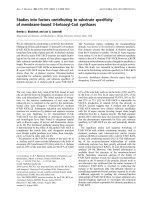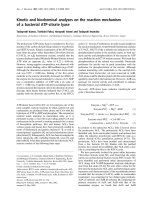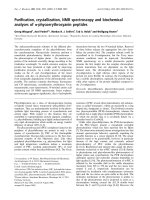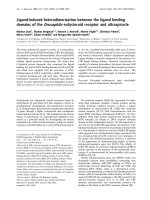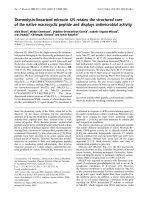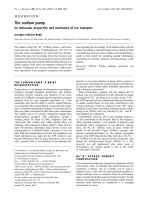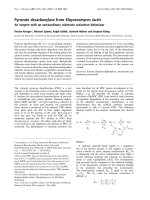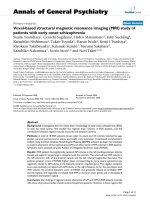Báo cáo y học: "Urine neutrophil gelatinase-associated lipocalin is an early marker of acute kidney injury in critically ill children: a prospective cohort study" pot
Bạn đang xem bản rút gọn của tài liệu. Xem và tải ngay bản đầy đủ của tài liệu tại đây (488.84 KB, 11 trang )
Open Access
Available online />Page 1 of 11
(page number not for citation purposes)
Vol 11 No 4
Research
Urine neutrophil gelatinase-associated lipocalin is an early
marker of acute kidney injury in critically ill children: a prospective
cohort study
Michael Zappitelli
1
*, Kimberly K Washburn
1
*, Ayse A Arikan
1
, Laura Loftis
1
, Qing Ma
2
,
Prasad Devarajan
2
, Chirag R Parikh
3
and Stuart L Goldstein
1
1
Texas Children's Hospital, Fannin Street, Houston, Texas 77030, USA
2
Cincinnati Children's Hospital Medical Center, Burnet Avenue, Cincinnati, Ohio 45229-3039, USA
3
Yale University School of Medicine, Campbell Avenue, West Haven, Connecticut 06516, USA
* Contributed equally
Corresponding author: Stuart L Goldstein,
Received: 20 Apr 2007 Revisions requested: 16 May 2007 Revisions received: 23 May 2007 Accepted: 2 Aug 2007 Published: 2 Aug 2007
Critical Care 2007, 11:R84 (doi:10.1186/cc6089)
This article is online at: />© 2007 Zappitelli et al.; licensee BioMed Central Ltd.
This is an open access article distributed under the terms of the Creative Commons Attribution License ( />),
which permits unrestricted use, distribution, and reproduction in any medium, provided the original work is properly cited.
Abstract
Introduction Serum creatinine is a late marker of acute kidney
injury (AKI). Urine neutrophil gelatinase-associated lipocalin
(uNGAL) is an early marker of AKI, where the timing of kidney
injury is known. It is unknown whether uNGAL predicts AKI in
the general critical care setting. We assessed the ability of
uNGAL to predict AKI development and severity in critically ill
children.
Methods This was a prospective cohort study of critically ill
children. Children aged between 1 month and 21 years who
were mechanically ventilated and had a bladder catheter
inserted were eligible. Patients with end-stage renal disease or
who had just undergone kidney transplantation were excluded.
Patients were enrolled within 24 to 48 hours of initiation of
mechanical ventilation. Clinical data and serum creatinine were
collected daily for up to 14 days from enrollment, and urine was
collected once daily for up to 4 days for uNGAL measurement.
AKI was graded using pRIFLE (pediatric modified Risk, Injury,
Failure, Loss, End Stage Kidney Disease) criteria. Day 0 was
defined as the day on which the AKI initially occurred, and
pRIFLEmax was defined as the worst pRIFLE AKI grade
recorded during the study period. The χ
2
test was used to
compare associations between categorical variables. Mann-
Whitney and Kruskal-Wallis tests were used to compare
continuous variables between groups. Diagnostic
characteristics were evaluated by calculating sensitivity and
specificity, and constructing receiver operating characteristic
curves.
Results A total of 140 patients (54% boys, mean ± standard
deviation Pediatric Risk of Mortality II score 15.0 ± 8.0, 23%
sepsis) were included. Mean and peak uNGAL concentrations
increased with worsening pRIFLEmax status (P < 0.05). uNGAL
concentrations rose (at least sixfold higher than in controls) in
AKI, 2 days before and after a 50% or greater rise in serum
creatinine, without change in control uNGAL. The parameter
uNGAL was a good diagnostic marker for AKI development
(area under the receiver operating characteristic curve [AUC]
0.78, 95% confidence interval [CI] 0.62 to 0.95) and persistent
AKI for 48 hours or longer (AUC 0.79, 95% CI 0.61 to 0.98), but
not for AKI severity, when it was recorded after a rise in serum
creatinine had occurred (AUC 0.63, 95% CI 0.44 to 0.82).
Conclusion We found uNGAL to be a useful early AKI marker
that predicted development of severe AKI in a heterogeneous
group of patients with unknown timing of kidney injury.
Introduction
Severe acute kidney injury (AKI) increases morbidity and mor-
tality of hospitalized patients [1-3]. Recent evidence suggests
that a small reduction in renal function, indicated by serum cre-
atinine (SCr), is an independent predictor of mortality and
length of hospital stay [1,4]. Laboratory research has revealed
that early intervention may be essential in preventing the
pathophysiologic events that lead to AKI [5,6]. Unfortunately,
SCr – the main AKI biomarker used in the clinical setting – is
a late marker of reduced glomerular filtration rate, which limits
AKI = acute kidney injury; AUC = area under the receiver operating characteristic curve; CI = confidence interval; CPB = cardiopulmonary bypass;
eCCL = estimated creatinine clearance; PICU = pediatric intensive care unit; pRIFLE = pediatric modified Risk, Injury, Failure, Loss, End Stage Kidney
Disease criteria; PRISM = Pediatric Risk of Mortality; SCr = serum creatinine; uNGAL = urine neutrophil gelatinase-associated lipocalin.
Critical Care Vol 11 No 4 Zappitelli et al.
Page 2 of 11
(page number not for citation purposes)
ability to detect AKI early and to initiate clinical therapeutic
studies. Therefore, recent research has focused on identifying
earlier biomarkers of AKI [7-12].
Neutrophil gelatinase-associated lipocalin (NGAL), a ubiqui-
tous 25 kDa protein, was isolated as a potential biomarker of
AKI using genomic microarray technology [12,13]. NGAL is
generally expressed in low concentrations, but it increases
greatly in the presence of epithelial injury and inflammation
[12,14,15]. Mishra and coworkers [16] observed a significant
rise in uNGAL (uNGAL) 2 days before the rise in SCr in chil-
dren with AKI following cardiopulmonary bypass (CPB). These
findings have now been confirmed in a prospective study of
adults who developed AKI after cardiac surgery [17], which
found uNGAL to be significantly elevated by one to three
hours after the operation. Other human studies [18-20] dem-
onstrated a strong relationship between uNGAL and AKI in
renal transplantation, diarrhea-associated hemolytic-uremic
syndrome, and lupus nephritis.
It is unknown whether the association between uNGAL and
AKI can be generalized to the critical care setting, in which the
population is heterogeneous and AKI etiology and timing are
often unclear. Furthermore, the prevalence of sepsis in the
intensive care unit (ICU) may limit the use of uNGAL as a spe-
cific biomarker of kidney injury. We studied uNGAL concentra-
tions in a group of critically ill children with the following goals:
to determine whether there is an association between uNGAL
and AKI in this heterogeneous group; to evaluate the effect of
sepsis and illness severity on the use of uNGAL to predict AKI;
to determine the extent to which uNGAL concentrations
increase before SCr in the setting of an unknown timing of ini-
tial kidney injury; and to evaluate the sensitivity and specificity
of uNGAL to predict the clinical course of AKI.
Materials and methods
Study design and subject selection
This study was performed concurrently with a prospective
observational study that validated pRIFLE (pediatric modified
Risk, Injury, Failure, Loss, End Stage Kidney Disease) criteria
for defining AKI in critically ill children [21]. Patients aged 1
month to 21 years, admitted to the pediatric ICU (PICU), who
received mechanical ventilation and underwent indwelling
bladder catheterization, were eligible for enrollment. Patients
with end-stage renal disease and who had just undergone
renal transplantation were excluded. Patient care givers pro-
vided written informed consent for the child to participate in
the descriptive study of AKI and for collection of urine sam-
ples. The study protocol and consent forms were approved by
the Baylor College of Medicine Human Subjects Institutional
Review Board before study initiation.
Clinical data collection
The following clinical variables were evaluated: patient age,
sex, height, and weight; admission and discharge diagnoses;
vasopressor use (yes/no) and number of vasopressors used;
renal replacement therapy provision; and 28-day mortality.
Patients with an admission or discharge diagnoses of sepsis,
septic shock, or systemic inflammatory response syndrome
were classified as having sepsis. The Pediatric Risk of Mortal-
ity (PRISM) II score (a measure of severity of illness/mortality
risk) was calculated on the day of ICU admission [22].
Laboratory data collection
SCr values were obtained prospectively as part of routine
patient care from the day of enrollment up to 14 days of the
study (or until PICU discharge if this occurred before 14 days).
At study completion, SCr values from PICU admission to study
enrollment were recorded retrospectively. Estimated creati-
nine clearance (eCCl) was calculated using the Schwartz for-
mula [23]. Patients were classified daily by pRIFLE criteria for
AKI, using changes in eCCl from baseline eCCl (Table 1).
Each patient's first AKI occurrence using pRIFLE criteria and
the worst pRIFLE status (pRIFLEmax) attained over 14 days
were recorded. Baseline renal function was defined as the
lowest known SCr value during the preceding 3 months.
Patients without known prior SCr were assumed to have nor-
mal baseline renal function and assigned a baseline eCCl of
120 ml/min per 1.73 m
2
. This cutoff was chosen because the
Schwartz eCCl overestimates glomerular filtration rate. For
those patients with no known baseline SCr and a PICU admis-
sion eCCl greater than 120 ml/min per 1.73 m
2
, their PICU
admission eCCl was recorded as their baseline renal function.
Urine specimen collection
Urine specimens were collected at 14:00 hours each day, for
up to four consecutive days, beginning on the day of enroll-
ment or the following day if consent was obtained after 14:00
hours (Figure 1a). Reasons for not collecting urine samples on
all four days included bladder catheterization discontinuation,
hospital discharge, death, and anuria. Urine bags were emp-
tied at 13:00 hours to allow collection of fresh urine in the fol-
lowing hour. Anuria was defined as less than 5 ml in the urine
collection bag from the hour before collection, because this
was the minimum amount required for processing and storage.
Urine processing was similar to that in previous studies
[18,19], in order to limit variations in findings resulting from dif-
ferences in sample handling. Urine specimens were kept on
ice until they were centrifuged at 3,000 rpm at 4°C for 5 min.
The supernatant was aliquoted equally into cryovials and
stored at -80°C. Pre-laboratory analysis sample handling
required minimal time and effort (approximately 10 min). De-
Samples were shipped to Cincinnati Children's Hospital Med-
ical Center for uNGAL and creatinine measurement; lab per-
sonnel were blinded as to any patient information and pRIFLE
status. Urine samples were analyzed for NGAL using an
established and validated enzyme-linked immunosorbent
assay [18,19,24]. Microtiter plates were coated overnight at
4°C with a mouse monoclonal antibody directed against
Available online />Page 3 of 11
(page number not for citation purposes)
human NGAL (#HYB211-05; AntibodyShop, Gentofte, Den-
mark). All subsequent steps were performed at room temper-
ature. Plates were blocked with buffer containing 1% bovine
serum albumin, coated with 100 μl sample (urine or serum) or
standards (NGAL concentrations ranging from 1 to 1000 ng/
ml), and incubated with a biotinylated monoclonal antibody
directed against human NGAL (#HYB211-01B; Antibody-
Shop) followed by avidin-conjugated horseradish peroxidase
(Dako, Glostrup, Denmark). TMB substrate (BD Biosciences,
San Jose, CA, USA) was added for color development, which
was read after 30 min at 450 nm with a microplate reader
(Benchmark Plus; BioRad, Hercules, CA, USA). Urine creati-
nine was measured using a quantitative colorimetric assay
(Sigma Chemical Co., St. Luois, MO, USA). All measurements
were taken in triplicate. The Cincinnati Children's Hospital
Medical Center laboratory was blinded to the AKI status of
each patient. Final uNGAL values were expressed in nano-
grams per milliliter and nanograms per milligram of creatinine.
Figure 1
Description of urine collection procedures and use of urine specimens with reference to analytic time pointsDescription of urine collection procedures and use of urine specimens with reference to analytic time points. (a) Overall urine collection procedure.
The image shows that study enrollment began shortly after initiation of ventilation and that urine was collected once per day for up to 4 days if possi-
ble. (b) Acute kidney injury (AKI) urine specimens collected before AKI development were used for assessment of urine neutrophil gelatinase-asso-
ciated lipocalin (uNGAL) for early detection of AKI. (c) AKI urine specimens collected within 24 hours of AKI by pRIFLE (pediatric modified Risk,
Injury, Failure, Loss, End Stage Kidney Disease) criteria were used to evaluate uNGAL as a marker of severity of renal injury. day 0, the first day the
patient attained AKI; PICU, pediatric intensive care unit; pRIFLEmax, the worst pRIFLE stratum attained; SCr, serum creatinine; uNGAL, urine neu-
trophil gelatinase-associated lipocalin.
Critical Care Vol 11 No 4 Zappitelli et al.
Page 4 of 11
(page number not for citation purposes)
Secondary exclusion of patients and urine samples
Before statistical analysis of urine samples, patients were fur-
ther excluded from this study if fewer than two SCr values
were available for the duration of the admission (and not
before early death) or if no urine specimens were collected
throughout the study period. If patients had even one urine
specimen collected, they were included.
Data management, interpretation, and analysis
Using all urine specimens available from all patients, the mean
and peak uNGAL concentrations from each patient were tab-
ulated. Mean and peak uNGAL were compared between con-
trol individuals and those with AKI (based on the R, I, and F
components of pRIFLEmax) during admission. The data were
examined for an association between mean or peak uNGAL
and the presence of sepsis, PRISM II scores, and mortality.
For all subsequent analyses, only data from urine samples for
which SCr was known in the 48 hours after urine collection
were used. We first examined whether uNGAL rises before
clinical evidence of AKI becomes apparent, as determined by
pRIFLE criteria. The data were arranged to define 'day 0' as
the first day on which a patient sustained AKI. Urine samples
collected between 72 hours before day 0 (days -3, -2, and -1;
Figure 1b) and 48 hours after day 0 (days 0, +1, and +2) were
compared with control uNGAL concentrations. Up to four con-
trol urine specimens per AKI urine specimen, drawn during the
same day of mechanical ventilation as the AKI patient, were
randomly selected for comparison using a random number
generator. Some control urine specimens are represented
more than once for comparison with different AKI urine
specimens.
The diagnostic characteristics of uNGAL in predicting AKI
were examined. The first urine specimen collected from AKI
patients who had urine collected before AKI development and
the first urine specimen collected from control individuals (Fig-
ure 1b) were used to calculate the sensitivity and specificity of
uNGAL in predicting the onset of AKI during the next 48 hours
and the onset of 'persistent' AKI durinng the next 48 hours.
'Persistent AKI' was defined as lack of complete resolution of
AKI within 48 hours, as a surrogate marker of patients who had
fluid responsive AKI. We only used the first urine specimen
collected from these patients to simulate the collection of urine
for NGAL measurement shortly after becoming 'at risk' (the
day of initiation of mechanical ventilation) but before the devel-
opment of AKI.
Table 1
Pediatric modified pRIFLE criteria for AKI using changes in
estimated creatinine clearance
pRIFLE stratum Change in eCCl
Risk (R) eCCl decrease by 25% from baseline renal
function
Injury (I) eCCl decrease by 50% from baseline renal
function
Failure (F) eCCl decrease by 75% from baseline renal
function or eCCl < 35 ml/min per 1.73 m
2
The original pediatric Risk, Injury, Failure, Loss, End Stage Kidney
Disease criteria [21] for acute kidney injury (AKI) also include pRIFLE
L (loss) and pRIFLE E (end stage kidney disease), identifying those
patients who require dialysis for periods longer than 30 days. eCCl,
estimated creatinine clearance; pRIFLE, pediatric modified Risk,
Injury, Failure, Loss, End Stage Kidney Disease.
Table 2
Patient characteristics by pRIFLEmax AKI status
Characteristic Control (n = 34) pRIFLEmax R (n = 50) pRIFLEmax I (n = 31) pRIFLEmax F (n = 25)
Age (years) 8.5 ± 6.2
a
/8 (11.0) 5.9 ± 6.7/2 (12.4) 4.4 ± 5.7/1 (8.7) 6.6 ± 6.4/4 (11.2)
PRISM II score
b
12.5 ± 7.7/12.5 (10) 14.2 ± 7.9/15 (13) 15.9 ± 7.3/16 (9) 19.0 ± 8.0/19 (12)
Day of admission enrolled (days) 2.8 ± 1.0/3 (1) 2.8 ± 1.1/2.5 (1) 3.3 ± 2.1/3 (2) 3.1 ± 1.7/3 (2)
Day of admission of pRIFLEmax NA 3.6 ± 3.6/2 (4) 2.5 ± 2.6/1 (2) 3.5 ± 4.0/1 (3)
Day of ventilation first urine collection 2.2 ± 0.7/2 (0.5) 2.5 ± 1.1/2 (1) 2.2 ± 0.8/2 (1) 2.3 ± 0.9/2 (1)
Days from day 0 of first urine collection
c
NA -0.8 ± 3.7/0 (4) 1.8 ± 2.2/1 (1) 1.7 ± 1.0/2 (1)
Male 18 (52.9) 27 (54.0) 18 (58.1) 12 (48.0)
Sepsis 7 (20.6) 4 (8.0)
d
12 (38.7) 9 (36.0)
Dialysis 0 0 2 (6.5) 5 (20.0)
30-day mortality 3 (8.8) 4 (8.0) 6 (19.4) 7 (28.0)
Values are expressed as mean ± standard deviation/median (interquartile range) or as n (%).
a
Control patients were older than those with
pRIFLEmax R and I acute kidney injury (AKI; P < 0.05, Mann-Whitney test).
b
Pediatric Risk of Mortality (PRISM) II score increased progressively
with increasing pRIFLEmax strata (P < 0.05, Kruskal-Wallis test).
c
Number of days from the day of AKI attainment that the first of four urine
samples was collected for each patient.
d
Patients in the pRIFLEmax R group had a lower proportion of sepsis, as compared with those in the
pRIFLEmax I and F groups (both P < 0.05, z-test). pRIFLEmax, the worst pRIFLE stratum attained; pRIFLE, pediatric modified Risk, Injury, Failure,
Loss, End Stage Kidney Disease.
Available online />Page 5 of 11
(page number not for citation purposes)
Several patients had their first urine sample collected on the
day of or one day after developing AKI (within 24 hours of the
first detected SCr increase, as shown in Figure 1c). We there-
fore evaluated the utility of uNGAL from day 0 or day +1 to pre-
dict persistent AKI and progression of AKI to a higher
pRIFLEmax stratum in patients who initially satisfied the R cri-
terion of pRIFLE.
Statistical analysis
Urine NGAL was non-normally distributed, and therefore non-
parametric testing was used to compare uNGAL concentra-
tions between groups (Mann-Whitney test for two groups and
Kruskal-Wallis test for multiple groups). Categorical variables
were analyzed using the χ
2
test, and proportions were com-
pared using the z-test. Diagnostic characteristics were calcu-
lated using standard 2 × 2 tables, and receiver operating
characteristic curves were constructed. Analyses were per-
formed using the Intercooled STATA
®
statistical software
package (Stata Corp., College Station, TX, USA). Values
which followed a normal distribution are expressed as mean ±
standard deviation and those which followed a non-normal dis-
tribution are expressed as median [interquartile range].
Results
Patient demographics
A total of 150 patients were enrolled in the AKI study con-
ducted to validate the pRIFLE criteria [21]. Ten patients were
excluded from urinary biomarker studies: five were anuric and
for five fewer than two SCr measurements were available. The
mean age was 6.3 ± 6.4 years (median 3.5 years, range 1
month to 21 years) and mean weight was 24.9 ± 21.5 kg
(median 15.6 kg) for the remaining 140 subjects (75 boys
[54%] and 65 girls [46%]). Nine patients had a baseline eCCl
below 90 ml/min per 1.73 m
2
; three patients had an eCCl
below 60 ml/min per 1.73 m
2
. The mean PRISM II score was
15.0 ± 8.0 (median 15). Thirty-two (23%) patients had a diag-
nosis of sepsis and 74 (53%) received vasopressors.
Mean PICU day of enrollment was 3.0 ± 1.5 days (median 3
days, range 1 to 9 days). Eighty-nine per cent of patients were
enrolled on or before PICU day 4. Urine collection began on
PICU day 3.0 ± 1.4 (median day 3) and day of ventilation 2.3
± 0.9 (median day 2).
Thirty-four (24.3%) patients never sustained AKI and served
as control individuals. A total of 106 (75.7%) patients devel-
oped AKI (35.7% [n = 50] satisfied the R criterion in their pRI-
FLEmax, 22.1% [n = 31] satisfied the I criterion in their
pRIFLEmax, and 17.9% [n = 25] satisfied the F criterion in
their pRIFLEmax). Baseline eCCl was similar between control
and AKI patients (median [interquartile range] 119 [38] ml/min
per 1.73 m
2
and 129 [87] ml/min per 1.73 m
2
, respectively; P
> 0.05). For 82% of patients with AKI, urine collections were
available between 72 hrs before and after day 0 of AKI.
Table 2 shows the characteristics of patients in the control
group and for those in each pRIFLEmax stratum (namely, those
satisfying the R, I, and F criteria in the pRIFLEmax for AKI).
Patients in the control group were older than those in the pRI-
FLEmax R and I groups. PRISM II scores increased progres-
sively with worsening pRIFLEmax strata (P < 0.05, Kruskal-
Wallis test), and the combined mortality of patients with pRI-
FLEmax I and F (n = 56) was higher than the combined mor-
tality of control and pRIFLEmax R patients (n = 84; P < 0.05,
z-test).
Association of mean and peak uNGAL concentrations
with pRIFLEmax
All urine specimens were used to calculate mean and peak
uNGAL. A total of 334 urine specimens were obtained from
Table 3
Peak and Mean uNGAL concentrations by pRIFLEmax status
Measurement Control pRIFLEmax R pRIFLEmax I pRIFLEmax F
Mean uNGAL
a
ng/mg creatinine 0.5 ± 1.5/0.1 (0.2) 0.6 ± 0.9
b
/0.3 (0.9) 1.7 ± 2.6
b
/0.7 (1.8) 2.8 ± 3.0
b,c
/1.5 (4.2)
ng/ml 14.2 ± 27.2/5.3 (13.2) 20.9 ± 28.1/11.6 (27.5) 58.9 ± 86.6
b
/20 (71.4) 82.7 ± 92.5
b,c
/35.0 (76.3)
Peak uNGAL
a
ng/mg creatinine 0.8 ± 2.0/0.2 (0.4) 1.0 ± 1.5
b
/0.4 (1.2) 2.5 ± 3.8
b
/0.9 (1.9) 3.8± 3.8
b,c
/1.8 (5)
ng/ml 24.6 ± 45.5/7.9 (20.0) 34.5 ± 47.4/14.7 (40.5) 82.9 ± 122.9
b
/25.0 (70.0) 103.2 ± 107.3
b,c
/55.0 (105.0)
Values are expressed as mean ± standard deviation/median (interquartile range).
a
Mean and peak urine neutrophil gelatinase-associated lipocalin
(uNGAL) concentrations increased with worsening pRIFLEmax acute kidney injury (AKI; all P < 0.0002, Kruskal-Wallis test), whether expressed in
ng/mg creatinine or ng/ml. These relationships were also statistically significant when examined by one-way analysis of variance (P < 0.0001).
b
Mean and peak uNGAL expressed in ng/mg creatinine was higher in patients with pRIFLEmax R, I and F AKI than in control patients (all P < 0.05,
Mann-Whitney test); mean and peak uNGAL expressed in ng/ml was higher in patients with pRIFLEmax R, I, and F AKI than in control patients (all
P < 0.05, Mann-Whitney test).
c
Mean and peak uNGAL was higher in patients with pRIFLEmax F AKI than in those with pRIFLEmax R and I AKI
(all P < 0.05, Mann-Whitney test), whether expressed in ng/mg creatinine or in ng/ml. pRIFLEmax, the worst pRIFLE stratum attained; pRIFLE,
pediatric modified Risk, Injury, Failure, Loss, End Stage Kidney Disease.
Critical Care Vol 11 No 4 Zappitelli et al.
Page 6 of 11
(page number not for citation purposes)
106 patients with AKI (3.2 specimens/patient) and 104 urine
specimens were obtained from 34 controls (3.1 specimens/
patient). For 75 patients urine specimens were available on all
four days, for 28 patients on three days, and for 17 patients on
two days; for 20 patients one urine specimen was available.
Table 3 shows the mean and peak uNGAL concentrations by
pRIFLEmax strata and Figure 2 illustrates the data graphically.
There was a statistically significant association between wors-
ening pRIFLEmax status and increasing mean and peak
uNGAL concentrations (all P ≤ 0.0002, Kruskal-Wallis test),
whether uNGAL was expressed as nanograms per milligram
creatinine or as nanograms per milliliter (Table 3). uNGAL
results are subsequently presented only in nanograms per mil-
ligram creatinine, because all associations observed held true
from uNGAL expressed in nanograms per milliliter, as found in
previous studies [16,18].
uNGAL as an early predictor of AKI
Figure 3 shows the uNGAL concentrations for patients with
AKI from days -3 to +2 of AKI. On day -3, uNGAL
concentrations were not different from control uNGAL con-
centrations (median [interquartile range] 0.0 [0.6] versus 0.1
[0.2] ng/mg creatinine; P > 0.05, Mann-Whitney test).
Whereas subsequent control uNGAL values remained low
(median ranging from 0.02 to 0.1 ng/mg creatinine), AKI
uNGAL concentrations were several fold higher than control
uNGAL concentrations from days -2 to +2 (median [interquar-
tile range] = 0.8 [2.0], 1.1 [2.0], 0.7 [2.0], 0.6 [1], and 0.8 [1]
ng/mg creatinine on days -2, -1, 0, +1, and +2, respectively;
all P < 0.05 versus control).
Diagnostic characteristics of uNGAL in predicting AKI
Patients for whom the first of four urine samples was collected
anytime before development of AKI (n = 21 urine specimens
with known SCr during the 48 hours following urine collection)
were analyzed to examine the diagnostic performance of
uNGAL for predicting the following outcomes: development of
any AKI in the next 48 hours and development of persistent
AKI in the next 48 hours. The first of four urine specimens (for
which SCr was known during the 48 hours following urine col-
lection) collected from patients in the control group were also
included (n = 24; Figure 1b). The area under the curve (AUC)
for receiver operating characteristic (ROC) for uNGAL for pre-
diction of any AKI within 48 hours of the first urine collection
was 0.78 (95% confidence interval [CI] 0.62 to 0.95; Figure
4a). The AUC for diagnosing persistent AKI in the next 48
hours was 0.79 (95% CI 0.61 to 0.98; Figure 4b). The sensi-
tivities and specificities for different uNGAL cutoffs are shown
in Table 4. At the lowest evaluated uNGAL concentration cut-
off of 0.05 ng/mg creatinine, sensitivity and specificity for
detecting AKI in the next 48 hours were 85% and 44%; at the
highest cutoff of 1.5 ng/mg creatinine, specificity was 97%
with a sensitivity was 54%.
Diagnostic characteristics of uNGAL in predicting the
course of AKI
We studied urine specimens collected within two days of initi-
ation of mechanical ventilation in AKI patients for whom the
first urine sample was collected on day 0 or day 1. We exam-
ined the diagnostic ability of uNGAL to predict persistent AKI
and progression of initial pRIFLE R AKI on day 0 to a worse
final pRIFLEmax. The AUC for day 0/+1 uNGAL for predicting
persistent AKI was 0.63 (95% CI 0.44 to 0.82), and the AUC
of uNGAL for predicting worsening from pRIFLE R to pRIFLE-
max I/F AKI was 0.61 (95% CI 0.32 to 0.89).
Figure 2
Mean and peak uNGAL concentrationsMean and peak uNGAL concentrations. Shown are box plots of (a)
mean and (b) peak urine neutrophil gelatinase-associated lipocalin
(uNGAL) concentrations by pRIFLEmax strata. The mean uNGAL is the
mean of uNGAL in each patient's four urine specimens, and peak
uNGAL is the highest uNGAL level from each patient. AKI, acute kidney
injury; pRIFLE, pediatric modified Risk, Injury, Failure, Loss, End Stage
Kidney Disease; pRIFLEmax, the worst pRIFLE stratum attained; R, pRI-
FLEmax R AKI; I, pRIFLEmax I AKI; F, pRIFLEmax F AKI.
Available online />Page 7 of 11
(page number not for citation purposes)
Association of uNGAL with PRISM II, mortality, and
sepsis
We observed a weak correlation between PRISM II scores
and mean and peak uNGAL concentrations in patients with
AKI (Spearman rho = 0.18 for both, P < 0.05) but not for
patients in the control group (Spearman rho = -0.01 and 0.04,
respectively; P > 0.05). There was no difference in peak or
mean uNGAL concentrations between survivors and nonsurvi-
vors when pRIFLEmax strata were examined separately (Table
5) or when the group was examined as a whole (P > 0.05,
Mann-Whitney test).
Thirty-two patients had a diagnosis of sepsis. One patient with
a positive urine culture in the setting of a multiorganism blood
infection attained pRIFLEmax R AKI with mean and peak
uNGAL concentrations similar to those of other patients with
pRIFLEmax R AKI, (0.6 and 0.8 ng/mg creatinine, respec-
tively). Sixteen (50%) patients had a positive blood culture and
had mean and peak uNGAL concentrations similar to those of
patients diagnosed with sepsis with a negative blood culture
(P > 0.5; data not shown). Septic patients with pRIFLEmax I/
F had higher mean and peak uNGAL concentrations than did
patients without sepsis (P < 0.05). This association was not
observed in control or pRIFLEmax R patients. The relationship
of increasing uNGAL values with worsening pRIFLEmax status
was present in patients with and in those without sepsis (both
P < 0.05, Kruskal-Wallis test; Figure 5), similar to when the
whole group was examined (Figure 2).
Discussion
We assessed the ability of uNGAL to predict AKI development
and characterize the degree of AKI in critically ill pediatric
patients. Our study is among the first to examine a urinary
biomarker in a heterogeneous population in which the timing
of renal insult is largely unknown [25]. Previous uNGAL stud-
ies [16,17,19,20] focused on a single renal disease entity or
were conducted in patient populations in which the timing of
renal insult was known or AKI development was predictable.
We found that uNGAL concentrations in AKI patients exhib-
ited a sixfold increase in concentration that persisted from 48
hours before to 48 hours after development of AKI. The timing
of uNGAL increase substantiates the findings of Mishra and
coworkers [16] in their study of NGAL in children who had
undergone CPB. Urinary NGAL concentrations of AKI patients
in our PICU population differed from those of other groups
described in the literature. For instance, uNGAL concentra-
tions for AKI patients in our study were 200-fold to 1000-fold
lower than renal transplant recipients with delayed graft func-
Figure 3
uNGAL concentrations from 3 days before to 2 days after sustaining AKIuNGAL concentrations from 3 days before to 2 days after sustaining
AKI. The center lines represent the median values and the two outer
lines represent the interquartile range. AKI, acute kidney injury; pRIFLE,
pediatric modified Risk, Injury, Failure, Loss, End Stage Kidney Dis-
ease; uNGAL, urine neutrophil gelatinase-associated lipocalin.
Figure 4
Receiver operating characteristic curve for uNGALReceiver operating characteristic curve for uNGAL. Shown are receiver
operating characteristic curve for uNGAL on days -2 or -1 used to pre-
dict development of (a) acute kidney injury (AKI) within 48 hours (area
under the receiver operating characteristic curve [AUC] 0.78) and (b)
persistent AKI within 48 hours of first urine collection (AUC 0.80).
Critical Care Vol 11 No 4 Zappitelli et al.
Page 8 of 11
(page number not for citation purposes)
tion [19] or with diarrhea-positive hemolytic-uremic syndrome
who required dialysis [20], and were 5-fold to 15-fold higher
than observed in the pediatric CPB cohort [16]. These differ-
ences in uNGAL concentration are expected because kidney
injury associated with primary renal insults may be more severe
than that in most patients included in our study, but our
patients were probably more severely ill, with a higher propor-
tion having sepsis, than children undergoing CPB. This finding
also confirms the need for future research to evaluate uNGAL
in different renal disease subgroups, in order to understand
fully how best to use uNGAL to diagnose AKI. Future research
should evaluate how specific diagnoses and medications
affect uNGAL levels, independently of AKI and sepsis.
We also found mean and peak uNGAL concentrations to be
associated with increasing pRIFLEmax strata, and uNGAL
concentrations from 24 and 48 hours before AKI development
predicted which patients would develop persistent AKI, with
good AUCs in the range of 0.78 to 0.79. Although the AUCs
in our study were not as robust as in previous studies, as noted
above, our study differed in the following ways: AKI timing in
our patients was unknown (unlike the CPB and immediate
post-renal transplant patient populations, where NGAL
concentrations can be tested at different specific time points
after the event that incites AKI); and our population was heter-
ogeneous as compared with uNGAL studies in primary renal
disease. Given these circumstances, we suggest that the
AUCs generated from our data indicate that uNGAL per-
formed reasonably well in terms of predicting AKI occurrence
and severity before AKI development. The diagnostic charac-
teristics of uNGAL in detecting AKI within 48 hours (Table 4)
suggest that a uNGAL cutoff value of 0.2 to 0.3 ng/mg creat-
inine provides the maximum sensitivity for a given specificity in
this patient population. Further studies in other critically ill pop-
Table 4
Diagnostic performance of different uNGAL thresholds to detect the development of AKI and persistent AKI within 48 hours
uNGAL cutoff
(ng/mg creatinine)
Sensitivity (%) Specificity (%) Correctly classified (%)
AKI Persistent AKI AKI Persistent AKI AKI Persistent AKI
0.05 85 89 44 42 56 51
0.1777853506056
0.2777872677369
0.3696775697369
0.4626781787676
0.8626784817878
1 626788838080
1.5545697927384
AKI, acute kidney injury; uNGAL, urine neutrophil gelatinase-associated lipocalin.
Table 5
Peak and mean uNGAL concentrations in survivors and nonsurvivors, by pRIFLEmax AKI strata
Measurement (ng/mg
creatinine)
Group (numbers of patients: survivors/nonsurvivors)
Control (31/3) pRIFLEmax R (46/4) pRIFLEmax I (25/6) pRIFLEmax F (18/7)
Peak uNGAL
a
Survivors 0.6 ± 1.8/0.1 (0.4) 0.9 ± 1.4/0.4 (1.2) 2.4 ± 3.5/0.8 (2.0) 4.1 ± 3.7/2.7 (5.5)
Nonsurvivors 0.4 ± 0.3/0.2 (0.5) 1.8 ± 2.7/0.7 (3.2) 2.7 ± 5.0/0.9 (1.0) 2.8 ± 4.0/1.5 (1.8)
Mean uNGAL
a,b
Survivors 0.4 ± 1.3/0.1 (0.2) 0.6 ± 0.8/0.3 (0.7) 1.6 ± 2.5/0.5 (1.8) 3.1 ± 3.1/2.2 (4.2)
Nonsurvivors 0.3± 0.2/0.2 (0.4) 1.1 ± 1.5/0.6 (2.1) 1.8 ± 3.0/1.0 (1.1) 1.9 ± 2.6/1.1 (1.1)
Values are expressed as mean ± standard deviation/median (interquartile range).
a
Peak and mean urine neutrophil gelatinase-associated lipocalin
(uNGAL) concentrations were not statistically significantly different between survivors and nonsurvivors in any of the pRIFLE strata (P > 0.05,
Mann-Whitney test).
b
Mean uNGAL refers to the mean of all 4 urine specimens collected for each patient. pRIFLEmax, the worst pRIFLE stratum
attained; pRIFLE, pediatric modified Risk, Injury, Failure, Loss, End Stage Kidney Disease.
Available online />Page 9 of 11
(page number not for citation purposes)
ulations should be performed to confirm the validity and gen-
eralizability of these cutoff values.
Previous reports have suggested that another urinary AKI
biomarker, interleukin-18, is elevated in critically ill adult
patients who later die, which can complicate the interpretation
of urinary interleukinn-18 in the most severely ill patients [25].
Although we observed a weak correlation between uNGAL
and PRISM II scores for the entire cohort, uNGAL
concentrations were no different between survivors and non-
survivors in control patients or at each pRIFLE stratum.
Absence of confounding by severity of illness is a desirable
quality in an AKI biomarker, because elevated levels are
unlikely to be due solely to illness severity or impending death.
In addition, despite the known association between uNGAL
and inflammation [14,15], we observed an association
between pRIFLEmax strata and increasing uNGAL concentra-
tions in patients with sepsis (whose level of systemic inflam-
mation is probably much higher than the intrarenal
inflammation associated with AKI) and in those without sepsis,
suggesting that uNGAL is an independent AKI biomarker.
Our study had several limitations. Because we studied only the
most critically ill patients (those who required mechanical ven-
tilation), many patients had already developed AKI at the time
of study enrollment. As a result, we obtained urine from only a
subgroup of patients for uNGAL assessment before AKI
development. We also only assessed uNGAL and SCr once
daily, and therefore we could have missed earlier rises in both
markers. We excluded patients whose urine output was less
than 5 ml during the hour before urine sampling. Such a strat-
egy could have led to potential exclusion of many patients who
were not truly anuric, but we only excluded five patients
because of low urine output in that hour. Although we previ-
ously validated the pRIFLE criteria, which are based on
changes in eCCl [21], use of eCCl to define AKI must be
interpreted with caution because eCCl formulae were origi-
nally derived in stable patients who were not critically ill. The
main reservation associated with use eCCl is related to
variability in SCr concentrations in the non-steady state.
Therefore, future research must attempt to identify other serum
markers of glomerular filtration rate, such as cystatin C, which
may not be greatly affected by rapid alterations in steady state
serum levels and may provide a more accurate 'gold standard'
against which early AKI biomarkers can be tested. Finally, it is
possible that the characteristics of uNGAL may not be the
same in clinical settings that we did not specifically assess (for
example, AKI due to nephrotoxic medication versus fluid-
related acute tubular necrosis). Our sample size was not large
enough to perform multiple subgroup analyses, and we chose
to focus on septic as opposed to nonseptic patients. Future
research must elucidate the utility of uNGAL as a diagnostic
marker of AKI in specific AKI etiologic entities.
Although our cohort represents a relatively large pediatric AKI
cohort, subgroup analyses must be viewed with caution.
Although we studied only the most critically ill patients, we
observed a 14.2% mortality rate. A larger sample size would
be required to provide adequate power for assessment of a
weak association between uNGAL and mortality. uNGAL con-
centrations were neither sensitive nor specific for predicting
the course of AKI once SCr was already elevated. Although
this finding suggests that uNGAL is not a good predictor of
AKI course once AKI has developed, our sample size might
have been too small to substantiate firmly this negative finding.
Other urinary markers should be examined for their utility to
determine AKI severity once SCr is already elevated, given that
Figure 5
Mean and peak uNGAL concentrations according to presence or absence of sepsisMean and peak uNGAL concentrations according to presence or
absence of sepsis. Shown are box plots of (a) peak urine neutrophil
gelatinase-associated lipocalin (uNGAL) concentrations in patients
with and without sepsis, by pRIFLEmax strata, and (b) mean uNGAL
concentrations in patients with and without sepsis. pRIFLE, pediatric
modified Risk, Injury, Failure, Loss, End Stage Kidney Disease; pRIFLE-
max, the worst pRIFLE stratum attained; uNGAL, urine neutrophil gelati-
nase-associated lipocalin.
Critical Care Vol 11 No 4 Zappitelli et al.
Page 10 of 11
(page number not for citation purposes)
SCr is still the standard for diagnosing AKI. Finally, it may not
be appropriate to extrapolate the results we obtained to adult
populations, who may exhibit greater degrees of chronic
inflammation.
Conclusion
AKI has emerged as an important health problem in hospital
patients. Recent efforts to define and characterize AKI [26,27]
have led to studies of early AKI detection and will ultimately
contribute to improvements in AKI outcomes. Data from the
present study suggest that uNGAL serves well in predicting
AKI before a rise in SCr becomes apparent and who will have
persistent AKI. It is likely that no urinary biomarker will be able
to perform all tasks of predicting AKI, for instance determining
both severity and duration, as well as portending recovery.
Although the use of urinary biomarkers is currently limited to
research investigations, and sample processing can only
occur at a few laboratories, the ultimate goal will be to develop
a biomarker panel in a urine dipstick format that permits rapid
assessment of biomarker threshold concentrations.
Competing interests
PD has entered into a licensing agreement for the NGAL assay
with Biosite Inc. (plasma NGAL) and Abbott Diagnostics
(uNGAL).
Authors' contributions
MZ participated in urine processing, performed the statistical
analysis, and drafted the manuscript. KKW participated in the
project coordination, recruitment, urine collection/processing,
and drafting of the manuscript. AAA participated in the project
coordination, recruitment, urine collection/processing, data
interpretation, and drafting of the manuscript. LL participated
in the study design and data interpretation. Qing Ma partici-
pated in the urinary NGAL measurements. PD performed
uNGAL measurements and participated in data interpretation.
CRP participated in the statistical analysis design and data
interpretation. SLG conceived and designed the study, and
participated in the data interpretation and manuscript drafting.
All authors approved the final manuscript.
Acknowledgements
Dr Zappitelli received post-doctoral research fellowship support from
the Kidney Research Scientist Core Education and National Training
(KRESCENT) program. We thank William S May and Patricia C Mapua
for their assistance with urine collections.
References
1. Chertow GM, Burcick E, Honour M, Bonventre JV, Bates DW:
Acute kidney injury, mortality, length of stay, and costs in hos-
pitalized patients. J Am Soc Nephrol 2005, 16:3365-3370.
2. Hoste EA, Clermont G, Kersten A, Venkataraman R, Angus DC, De
Bacquer D, Kellum JA: RIFLE criteria for acute kidney injury are
associated with hospital mortality in critically ill patients: a
cohort analysis. Crit Care 2006, 10:R73.
3. Uchino S, Bellomo R, Goldsmith D, Bates S, Ronco C: An assess-
ment of the RIFLE criteria for acute renal failure in hospitalized
patients. Crit Care Med 2006, 34:1913-1917.
4. Price JF, Mott AR, Dickerson HA, Jefferies JL, Nelson DP, Chang
AC, Smith EO, Towbin JA, Dreyer WJ, Denfield SW, Goldstein SL:
Worsening Renal Function in Children Hospitalized with Acute
Decompensated Heart Failure: Evidence for a Pediatric Cardi-
orenal Syndrome? Pediatric Critical Care Medicine in press.
5. Schrier RW, Wang W, Poole B, Mitra A: Acute renal failure: def-
initions, diagnosis, pathogenesis, and therapy. J Clin Invest
2004, 114:5-14.
6. Star RA: Treatment of acute renal failure. Kidney Int 1998,
54:1817-1831.
7. Bonventre JV, Zuk A: Ischemic acute renal failure: an inflamma-
tory disease? Kidney Int 2004, 66:480-485.
8. Han WK, Bailly V, Abichandani R, Thadhani R, Bonventre JV: Kid-
ney Injury molecule-1 (KIM-1): a novel biomarker for human
renal proximal tubule injury. Kidney Int 2002, 62:237-244.
9. Herget-Rosenthal S, Marggraf G, Husing J, Goring F, Pietruck F,
Janssen O, Philipp T, Kribben A: Early detection of acute renal
failure by serum cystatin C. Kidney Int 2004, 66:1115-1122.
10. Herget-Rosenthal S, Pietruck F, Volbracht L, Philipp T, Kribben A:
Serum cystatin C: a superior marker of rapidly reduced
glomerular filtration after uninephrectomy in kidney donors
compared to creatinine. Clin Nephrol 2005, 64:41-46.
11. Hewitt SM, Dear J, Star RA: Discovery of protein biomarkers for
renal diseases. J Am Soc Nephrol 2004, 15:1677-1689.
12. Schmidt-Ott KM, Mori K, Kalandadze A, Li JY, Paragas N, Nicholas
T, Devarajan P, Barasch J: Neutrophil gelatinase-associated
lipocalin-mediated iron traffic in kidney epithelia. Curr Opin
Nephrol Hypertens 2006, 15:442-449.
13. Cowland JB, Borregaard N: Molecular characterization and pat-
tern of tissue expression of the gene for neutrophil gelatinase-
associated lipocalin from humans. Genomics 1997, 45:17-23.
14. Carlson M, Raab Y, Seveus L, Xu S, Hallgren R, Venge P: Human
neutrophil lipocalin is a unique marker of neutrophil inflamma-
tion in ulcerative colitis and proctitis. Gut 2002, 50:501-506.
15. Xu SY, Pauksen K, Venge P: Serum measurements of human
neutrophil lipocalin (HNL) discriminate between acute bacte-
rial and viral infections. Scand J Clin Lab Invest 1995,
55:125-131.
16. Mishra J, Dent C, Tarabishi R, Mitsnefes MM, Ma Q, Kelly C, Ruff
SM, Zahedi K, Shao M, Bean J, et al.: Neutrophil gelatinase-
associated lipocalin (NGAL) as a biomarker for acute renal
injury after cardiac surgery. Lancet 2005, 365:1231-1238.
17. Wagener G, Jan M, Kim M, Mori K, Barasch JM, Sladen RN, Lee
HT: Association between increases in urinary neutrophil gela-
tinase-associated lipocalin and acute renal dysfunction after
adult cardiac surgery. Anesthesiology 2006, 105:485-491.
18. Brunner HI, Mueller M, Rutherford C, Passo MH, Witte D, Grom A,
Mishra J, Devarajan P: Urinary neutrophil gelatinase-associated
lipocalin as a biomarker of nephritis in childhood-onset sys-
temic lupus erythematosus. Arthritis Rheum 2006,
54:2577-2584.
19. Parikh CR, Jani A, Mishra J, Ma Q, Kelly C, Barasch J, Edelstein CL,
Devarajan P: Urine NGAL and IL-18 are predictive biomarkers
for delayed graft function following kidney transplantation. Am
J Transplant 2006, 6:1639-1645.
20. Trachtman H, Christen E, Cnaan A, Patrick J, Mai V, Mishra J, Jain
A, Bullington N, Devarajan P, Investigators of the HUS-SYNSORB
Pk Multicenter Clinical Trial: Urinary neutrophil gelatinase-asso-
Key messages
• uNGAL concentrations rose 48 hours before a 50% or
greater rise in SCr, in a heterogeneous group of criti-
cally ill children.
• uNGAL is good diagnostic marker of AKI in settings in
which the timing of kidney injury is unknown.
• Children with sepsis have higher uNGAL concentra-
tions than do those without sepsis, but the relationship
between uNGAL and AKI is maintained.
• uNGAL may not be a good predictor of AKI severity,
once SCr rise has already occurred.
Available online />Page 11 of 11
(page number not for citation purposes)
ciated lipocalcin in D+HUS: a novel marker of renal injury.
Pediatr Nephrol 2006, 21:989-994.
21. Akcan-Arikan A, Zappitelli M, Loftis LL, Washburn KK, Jefferson
LS, Goldstein SL: Modified RIFLE criteria in critically ill children
with acute kidney injury. Kidney Int 2007, 71:1028-1035.
22. Pollack MM, Ruttimann UE, Getson PR: Pediatric risk of mortality
(PRISM) score. Crit Care Med 1988, 16:1110-1116.
23. Schwartz GJ, Haycock GB, Edelmann CM Jr, Spitzer A: A simple
estimate of glomerular filtration rate in children derived from
body length and plasma creatinine. Pediatrics 1976,
58:259-263.
24. Mishra J, Ma Q, Prada A, Mitsnefes M, Zahedi K, Yang J, Barasch
J, Devarajan P: Identification of neutrophil gelatinase-associ-
ated lipocalin as a novel early urinary biomarker for ischemic
renal injury. J Am Soc Nephrol 2003, 14:2534-2543.
25. Parikh CR, Abraham E, Ancukiewicz M, Edelstein CL: Urine IL-18
is an early diagnostic marker for acute kidney injury and pre-
dicts mortality in the intensive care unit. J Am Soc Nephrol
2005, 16:3046-3052.
26. Mehta RL, Kellum JA, Shah SV, Molitoris BA, Ronco C, Warnock
DG, Levin A, the Acute Kidney Injury Network: Acute Kidney
Injury Network: report of an initiative to improve outcomes in
acute kidney injury. Crit Care 2007, 11:R31.
27. Ricci Z, Ronco C: Year in review: critical care 2004 –
nephrology. Crit Care 2005, 9:523-527.
